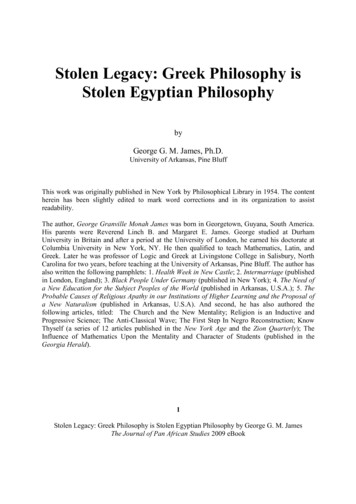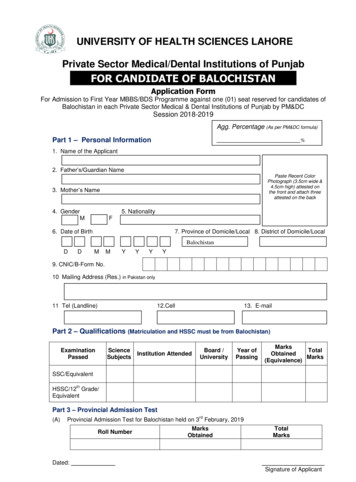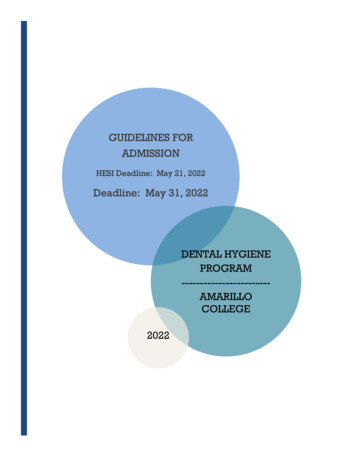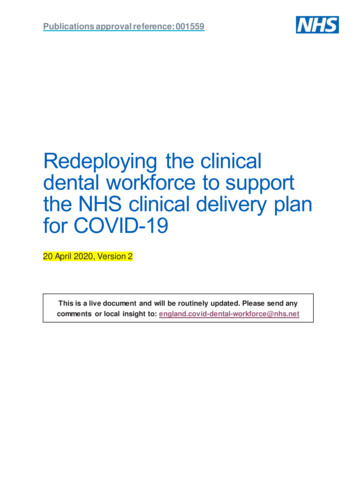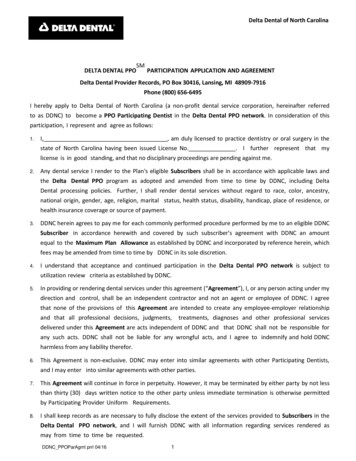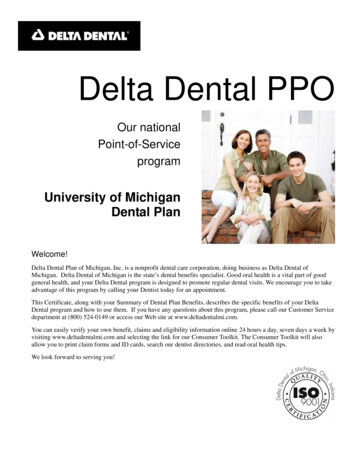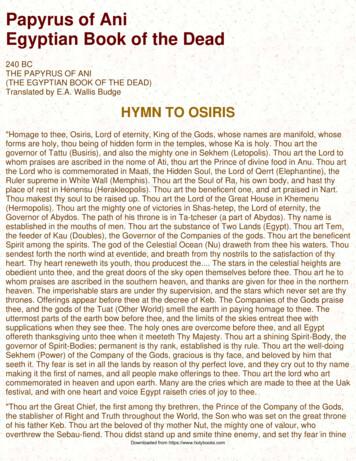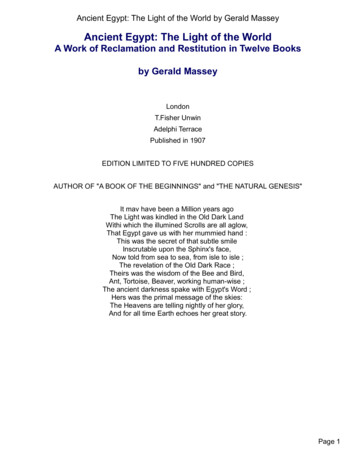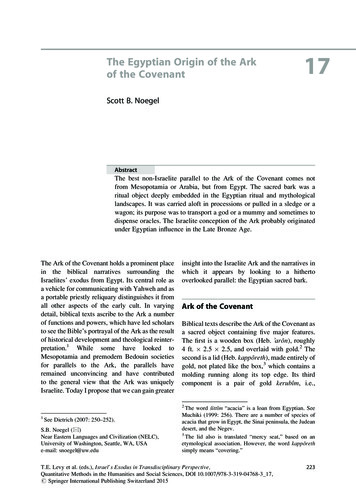
Transcription
EGYPTIANDENTAL JOURNALVol. 65, 3787:3794, October, 2019I.S.S.N 0070-9484Fixed Prosthodontics, Dental materials, Conservative Dentistry and Endodonticswww.eda-egypt.org Codex : 128/1910DIGITAL PEEK FRAMEWORK AND PATIENT SATISFACTIONCOMPARED TO CONVENTIONAL METAL FRAMEWORK INREMOVABLE PARTIAL DENTURES. A CLINICAL TRIALSeham E. Mohamed* and Hashem Rasha G. **ABSTRACTIntroduction: Utilization of removable partial dentures (RPD) is inevitable in some patientsthat are not indicated for any other treatment option, thus patient satisfaction with this line oftreatment is of great importance. However, a notable need exists to advance materials and fabricationtechnologies due to the undesirable health outcomes linked with current RPDs.Aim: In this study patient satisfaction with conventionally manufactured metal RPD framework,was compared with their satisfaction using digitally milled PEEK (Juvora) framework.Methods: Ten patients were selected having class I partially edentulous mandibles. Aconventional metal framework RPD was constructed for each patient, then another RPD withmilled PEEK framework was digitally fabricated for each one of them. Each patient had the chanceto use each denture for three months, then questionnaires were filled to assess their satisfaction.Results: The questionnaires were statistically analyzed and resulted in more patients’ satisfactionwith the digital PEEK framework RPD, than with conventional metallic RPD framework.Conclusion: PEEK material increases patients’ satisfaction with RPDs than the conventionalmetal framework material, thus decreasing patients’ complaints from removable appliances.KEY WORDS: Digital workflow, CAD/CAM, digital RPD, PEEK (Juvora), distal extensionRPD, patient satisfaction.INTRODUCTIONPartially dentate adults’ number is increasingcompared to completely edentulous individuals,in part as a result of the expanded life anticipation,increase in number of elderly individuals dueto rise in health care measures, and a shift fromcomplete tooth loss toward partial edentulism (1, 2, 3).The improvement in oral health resulted in peopleextracting fewer teeth, and increasingly needingtreatment of partial rather than complete edentulism(2). Restoration of lost teeth and associated* Lecturer in Removable Prosthodontics Department, Ahram Canadian University,** PhD. of Removable Prosthodontics
(3788)E.D.J. Vol. 65, No. 4structures is important to, upgrade appearance,reinforce masticatory efficiency, prevent unwantedmovements of teeth (overeruption/drifting) andimprove phonetics. Quality of patient’s lifebecomes better when aesthetics and functions ofstomatognathic system are improved (4).Given the relation between edentulism (completeor partial) and low socioeconomic status, RPDs willprobably represent an essential treatment optionin comparison with more costly alternatives (5).Thus RPDs exceeds conservative implant toothreplacements because of their accessibility to thislow socioeconomic groups in whom the highestrates of missing teeth occurs (6).RPDs can be indicated to overcome financialrestrictions, as interim prostheses, to ease hygieneaccess, or to overcome biomechanical and pragmaticmatters associated with other restorative options(1). Long-span edentulous spaces are difficult tobe replaced with fixed prostheses, resulting inpoor prognosis. RPDs are also the best strategyfor many clinical scenarios, such as substitutingmissing hard and soft tissues, that result in a needfor esthetic support of the orofacial structures (1, 7).Free end RPDs are of the most critical situations inachieving long term success without endangeringthe remaining tissues, especially in the mandible asit has decreased amount of bony ridge (8).Patients seeking teeth replacement comes tothe dental clinics with varying expectations andprevious experiences. Patient satisfaction withthe prosthesis can have a profound impact on thesuccess of treatment, because dissatisfaction witha RPD will likely lead to disuse and subsequentrehabilitation failure (9). In this respect, treatment ofpartially edentulous ridges with removable partialdentures is satisfactory for majority of cases (10). Nomatter how skilled a professional is some patientsare still not satisfied with RPDs, therefor patientacceptance of the prosthesis plays a major role in itssuccess (11). Satisfaction with the dental prosthesisis multifactorial, involving technical and patientSeham E. Mohamed and Hashem Rasha G.related variables. Comfort, masticatory ability,aesthetics and retention seem to be the major factorsfor satisfaction with the prosthetic appliance (9, 12).The benefits of metal-based frameworks overacrylic resin are, it can be utilized in thin sectionswith decreased bulk, has higher strength andstiffness, transmit heat and cold allowing naturaltissues stimulation, allow designs that diminishgingival margins coverage, permit a stable denturebase, undergo repassivation, and are resistantto corrosion (13). Although cobalt-chromium isusually considered the best material for a dentureframework, its physical properties are not ideal.Esthetically unacceptable display of metal clasps,increased prosthesis weight, potential for metallictaste, oral galvanism, osteolysis of abutmentteeth, biofilm production and allergic reactions tometals have led to the introduction of a number ofthermoplastic materials in clinical practice (1, 13-15).Application of digital technology to removableand fixed prosthesis’ design and construction, is advancing rapidly. Computer-aided design and computer-aided manufacturing (CAD-CAM) systemsare being widely used in the design and constructionof prosthodontics. CAD-CAM techniques have beentested as a technique of surveying 3D-scanned dental models to create RPD frameworks (4). Differentsoftware types are used to design RPD frameworks.The main restriction hindering the wide applicationof a complete RPD digital workflow is the difficultyand expenses associated with the metal frameworksproduction (16). Recent technology as 3D scannersand denture designing software modules promiseimprovements in RPD production (4).Digital dentistry in general utilizing CADCAM technology, high precision 3D printers andscanners, mass industrial casting and productiontechniques are predicted to enhance the fit, esthetics,and functional components of RPDs while reducingcosts and effort, hence increasing potency andmanufacturing outcomes (17).
DIGITAL PEEK FRAMEWORK AND PATIENT SATISFACTIONDigital solutions grant the application of recentmaterials that would not be utilized for RPDfabrication, except digitally. Polymers are especiallyconsidered because of their ease of construction anddesirable properties (16).Various developments of new polymers bymodifying existing materials with the additionof fillers such as glass, silica, borosilicate, andfused quartz (18). Some advantages of polymerbased frameworks over metal frameworks are theirimprovement of esthetics due to their translucencyand color, more cost-effective, high elasticity,straightforward manufacturing, lightweight, lowwater sorption and solubility, and are easily repairedand reconstructed (13, 15).One of the recently introduced materials indentistry is the polyether ether ketone (PEEK)which is white, radiolucent, rigid material withgreat thermal stability (19). It is non allergic with lowplaque affinity (20). PEEK’s mechanical propertiesare not changed during sterilization, weather usingsteam, gamma and ethylene oxide (19). Young’s(elastic) modulus and tensile properties are closeto human bone, enamel and dentin. Polyether etherketone is resistant to hydrolysis, non-toxic and isone of the best biocompatible materials (19, 20). It hasa special chemical structure, which exhibits stablechemical and physical properties with low watersolubility and absorption (21). Juvora disc made fromPEEK-OPTIMA is a high performance polymerthat can be used for long term fixed and removablerestorations (20).AIMThe aim of this study is to evaluate patientsatisfaction with an alternative treatment approachusing digitally milled PEEK (Juvora) frameworkRPDs, and compare it with their satisfaction usingconventional metal framework RPDs in patientshaving class I edentulous mandibles.(3789)MATERIALS AND METHODS:Ten partially edentulous patients were selectedfrom the out-clinic, Faculty of Oral and DentalMedicine, Ahram Canadian University, havingmandibular class I Kennedy classification seekingto restore their missing tissues. The patients’ agegroup was ranged from 30 to 50 years, and theyall had no previous experience in RPD wearing.Informed consent was obtained from each patientparticipating in the study.Each patient was carefully diagnosed, andconventional RPD with Cr Co metal frameworkwas constructed with the conventional technique.Patients were instructed to use their RPDs for threemonths, after all the follow up adjustments werefinished. A questionnaire was filled by each patientto assess his satisfaction with the RPD consideringretention, mastication, esthetics, hygiene, andcomfort at the end of the three months.Another RPD was digitally fabricated for eachpatient from milled PEEK (Juvora) material asa non-metallic framework. A duplicate from thepatient’s master cast was poured in extra hard stone(type IV, Elite Rock; Zhermack) to be scanned onthe 3d scanner (Zirkonzahn S600 ARTI Scanner,Italy) with a scanning software, to create virtualmodel obtaining a standard tessellation language(STL) file format, which was then imported to theCAD soft-ware (3Shape Dental System, version2.9.9.3) used to start the design process. The virtualmodel was digitally surveyed to delineate the surveyline, determine the most suitable path of insertion,and block out all the undesirable undercuts. Theframework was digitally designed on the virtualcast that resembles the Cr Co framework designwith the exception of slight increase in thicknessto allow for the desired rigidity needed for PEEKframework (Figure 1). The major connector wasdesigned to be lingual plate not lingual bar as inthe metal framework design to provide enoughthickness of PEEK material. The characteristic
(3790)E.D.J. Vol. 65, No. 4Seham E. Mohamed and Hashem Rasha G.then finishing and polishing was conducted. Theframework was tried in the oral cavity and checkedfor accuracy of adaptation, then the subsequentsteps were conducted according to the conventionaltechniques. Patients were instructed to use the PEEKdentures for three months after the last follow upadjustments conducted, then the same questionnairewas filled (Figure 3).Fig. (1) Digitally designed frameworkfeatures of the framework, including the half pearshaped cross section of lingual plate, the internaland external finish lines, the tissue stops at the tissuesurface of mesh construction were applied. Theframework thickness was 0.8mm., as required per(PEEK) material mechanical properties. The designwas then checked and reviewed to assure smoothand rounded margins and connections between thecomponents. The design data on the STL file of thesoftware was saved.The framework was milled by the millingmachine (Figure 2) (Roland DWX-50, 5-AxisDental milling Machine, Chicago, USA) from aready-made PEEK disc (Juvora Ltd., Technologycenter, Hilhouse International, Thornton Cleveleys,Lancashire, UK), which has no filler content,Fig. (3) PEEK RPD in patient’s mouthFig. (2) The milling machinePatient satisfaction was compared from thequestioners obtained after. The questioner usedin this study was the Arabic version of the OralHealth Impact Profile in edentulous patients (OHIPEDENT) the 19 questions form, which evaluatesquality of patients’ live and their satisfaction with theprosthetic appliance. The OHIP-EDENT questionerevaluates functional limitations, physical pain ordisability, psychological discomfort or disability,
(3791)DIGITAL PEEK FRAMEWORK AND PATIENT SATISFACTIONsocial disability and handicap. It is recognized bythe WHO as an important segment of the GlobalOral Health Program (2003) (22).Data was tabulated and analyzed. Statisticalanalysis of the obtained data was conducted by theuse of ANOVA (analysis of variance) test to detectif there was significant difference between patients’satisfaction with each type of frameworks. Duncan;s(Duncan’s multiple range) test was then applied todistinguish which type of frameworks was moresatisfying to the patients under this investigation.RESULTSDuring the conduction of this study, somepatients complained from the unaesthetic displayof metal with the conventional metal frameworksRPDs before the conduction of the questioner andpreferred to have RPDs with more esthetic nonmetallic show and tooth colored frameworks.Most of the patients under this investigation weremore accepting the idea of using a removable devicewith a non-metal framework, for the avoidance ofmetallic taste and the galvanism experienced withthe metal frameworks.Considering PEEK frameworks (Table 1), itwas found that concerning functional limitation,30% of the patients indicated difficulty in chewingfoods sometimes. In physical pain, 50% of patientsexperienced painful aching rarely, in physicaldisability, 40% of patients rarely avoided eatingsome foods because of problems with their dentures.In psychological discomfort, 55% of patientsindicated never being worried by dental problems,in psychological disability, 40% of patients havenever been unable to eat. In social disability, 70%of patients have never avoided going out, and inhandicap, 75% of patients have never been unableto enjoy company and unsatisfied.Considering metal frameworks (Table 2), it wasfound that concerning functional limitation, 30% ofthe patients indicated difficulty in chewing foodsoften. In physical pain, 40% of patients experiencedpainful aching sometimes, in physical disability,60% of patients avoided eating some foodssometimes because of problems with their dentures.In psychological discomfort, 35% of patientsindicated rarely being worried by dental problems,in psychological disability, 35% of patients haverarely been unable to eat. In social disability, 47%of patients have rarely avoided going out, and inTable (1) Questioner answers for PEEK frameworksPEEKFrameworksNever Rarely Sometimes Often AlwaysFunctionallimitation20%30%30%20%0Physical 75%5%15%5%040%30%Table (2) Questioner answers for metal frameworksMetalFrameworksNever Rarely Sometimes Often AlwaysFunctional030%20%30%20%Physical tdisabilitydisability010%60%
(3792)E.D.J. Vol. 65, No. 4handicap, 35% of patients have never been unableto enjoy company and unsatisfied.Statistical analysis was conducted by the use ofANOVA test of the answered questioner for eachpatient about his conventional metallic frameworkRPD and his milled PEEK (Juvora) frameworkRPD, at a confidence interval of 95% and the nullhypothesis (meaning there was no difference inpatients’ satisfaction between the two denture types)was rejected, which means that there is significantdifference in patient satisfaction values between theconventional metal framework RPDs and the JuvoraPEEK framework RPDs. Duncan’s multiple rangetest was conducted to differentiate between meansof the patients’ answers to evaluate the degree ofpatients’ satisfaction with each RPD type. Duncan’stest revealed that patients were more satisfied withthe milled PEEK (Juvora) framework RPD thanwith conventional metallic framework RPD. Themean of overall patients’ satisfaction in case ofPEEK framework was found to be 1.98 0.51, andthe mean of overall patients’ satisfaction in case ofmetal frameworks was found to be 2.0 0.51.DISCUSSIONIn the current study patients were treated withRPDs to restore function and improve their qualityof life which is in agreement with Campbell et. al.(16)who stated that, treatment with RPDs should ideally results in improvements in overall oral health,patient satisfaction, and compliance. Design, materials, ease of repair, patient education, and followup for RPD treatment all are pragmatic issues thathave a significant impact on treatment success.This study aim was to evaluate patient satisfaction,in which Cimas et. al. (23) stated that, research onquality of health care and patient satisfaction isconstantly increasing nowadays. Carlsson (24) statedthat, considering that patient satisfaction is theultimate objective during oral rehabilitation, it isinteresting to note that few studies were performedto verify and understand the factors that affect thissatisfaction.Seham E. Mohamed and Hashem Rasha G.Patients under this investigation were found tobe more satisfied with PEEK frameworks than withmetal frameworks in denture retention and stability,which is in agreement with Keltjens et. al. (25) whostated that, retainers (metal clasps) after 8 years ofnormal use were found to be distorted and that overtime they did not fit the abutment correctly. On thecontrary Tannous et. al. (26) stated that, clasps madeof PEEK have lower resistance forces than the onesmade from cobalt – chrome.Using digitally fabricated milled PEEK frameworks was conducted to allow more adaptation ofthe prosthesis and better retention, and this is in accordance with Campbell et. al. and Harb et. al.(16,27)who stated that, digital strategies widen the scope oftherapeutic applications for partial dentures as a result of improved design and production control, newmaterials, and improved efficiencies with adequatefit that will likely enhance outcomes and improvepatient experiences. However, digital fabrication ishigher in cost than the conventional lost-wax fabrication technique and metallic RPD frameworks,thus it may be restricted for partially edentulous patients with financial constraints.It was found in this study that patients weremore satisfied with PEEK frameworks which was inaccordance with Skirbutis et. al. (28) who mentionedthat mechanical properties of PEEK are similar todentin and enamel, thus it has superiority over metalalloys and ceramic restorations, as PEEK has highfracture load resistance, it is suitable for producingframes.Harb et. al. (27) also concluded that, the low specificweight of PEEK material permits the fabrication oflighter prostheses with good functionality, this willbe in agreement with the results of our study.Stawarczyk et. al. (29) reported that, PEEK matrixwith no filler content was found to be more stablethan with fillers in the nanoscale range. Jouvoramaterial is the purest form of PEEK without fillerthus used safely in the oral cavity.
DIGITAL PEEK FRAMEWORK AND PATIENT SATISFACTIONOn the contrary a study by Zoidis et. al. (20)concluded that, in the absence of more clinicalstudies along with some concerns about PEEK’sbehavior under fatigue stresses during use, suggeststhat it should still be used with caution and yetcannot be recommended as an alternative to cobaltchromium frameworks.In the present study, the questionnaire used wasin agreement with Dervis (30), in which it includedall the necessary parameters related to denturesfunctionality, possible occurrence of pain, and thepsychological and social aspects of their use. Theanswers to these questions are a clear indication ofhow patients feel about their dentures.Raina et. al. (31) reported that, the poor self-perceived satisfaction among denture wearers affecttheir quality of life. There was no difference foundin the patients’ satisfaction between patients withtheir first ever RPD and the patients who had previous experience (32). Shetty et al (11) when studiedpatient satisfaction with RPDs, reported that whencomfort with chewing, laughing, swallowing, inserting or removing the denture was evaluated,9.6% were comfortable with the prosthesis, 22%were satisfied with the appearance, and only 1% ofthe subjects were found to be satisfied with the retention and stability.The limitations of the present study include asmall sample size as well as the use of a quantitativeapproach and correlation-based analysis, whichlimits the evaluation of a cause–effect relationshipamong the evaluated variables.CONCLUSIONDigitally fabricated removable partial dentureframeworks made of PEEK (Juvora) materialallows removable partial denture patients to be moresatisfied with their prosthesis than conventionalmetal frameworks, thus extending the application ofremovable partial dentures and decreasing patients’rejection to the removable appliances, which willserve to restore more partially edentulous cases withgreat satisfaction and least complaints.(3793)REFERENCES1.Benso B., Kovalik A. C., Jorge J. H., et al.: Failures in therehabilitation treatment with removable partial dentures.Acta Odontolgia Scandnevian. 2013; 71: 1351-1355.2.Douglass C. W. and Watson A. J.: Future needs for fixedand removable partial dentures in the United States.Journal of Prosthetic Dentistry. 2002; 87: 9-14.3.Allen P. F. and McMillan A. S.: A review of the functionaland psychosocial outcomes of edentulousness treatedwith complete replacement dentures. Journal of CanadianDental Association. 2003; 69(10): 662-662e.4.Bohnenkamp D. M.: Removable partial dentures: clinicalconcepts. Dental Clinical Northen American. 2014;58: 69-89.5.Preshaw P. M., Walls A. W., Jakubovics N. S., et al.:Association of removable partial denture use with oral andsystemic health. Journal of Dentistry. 2011; 39: 711-719.6.Ramamoorthi M. and Khuraif A. A. A.: A Comparativeevaluation of fatigue behavior of removable partial denturealloys with and without heat treatment. InternationalJournal of Dental Clin. 2011; 3(1): 14-17.7.Mazurat N. M. and Mazurat R. D.: Discuss beforefabricating: communicating the realities of partial denturetherapy. Part I: patient expectations. Journal of CanadianDental Association. 2003; 69: 90-94.8.Manumeet B., Jitender B., Gyanander A., et al.: A reviewon stresses- induced by removable partial dntures.International Journal of Contemporary Dentistry MedicineRev. 2015; 10: 1-5.9.Koyama S., Sasaki K., Yokoyama M., et al.: Evaluation offactors affecting the continuing use and patient satisfactionwith removable partial dentures over 5 years. Journal ofProsthetic Research 2010; 54: 97-101.10. Sharma A. and Tabassum A.: Evaluation of patientsatisfaction for retention, masticatory efficacy, aestheticsand comfort for removable partial denture: A retrospectivestudy. International Journal of Applied Dental Sciences.2018; 4(1): 91 -93.11. Shetty M. S., Panchamal G. S. and Shenoy K.: Patientsatisfaction with removable partial dentures and relatedfactors - A pilot study. Journal of Contemporary Medicine.2015; 5(1): 13-17.12. Ducia C. C., Simone M. B., Eduardo D. L. F., et al.: Functional evaluation of oral rehabilitation with removable
(3794)E.D.J. Vol. 65, No. 4partial dentures after five years. Journal of Applied OralScince. 2006; 14(2): 111-116.13. Wiesli M. G. and Ozcan M.: High-performance polymersand their potential application as medical and oral implantmaterials: a review. Implant Dentistry. 2015; 24: 448-457.14. Behr M., Zeman F. and Passauer T.: Clinical performanceof cast clasp-retained removable partial dentures: A retrospective study. International Journal of Prosthodontics.2012; 25: 138-144.15. Schwitalla A. D., Spintig T., Kallage I., et al.: Flexural behavior of PEEK materials for dental application. DentalMaterials. 2015; 31: 1377-1384.16. Campbell S. D., Cooper L., Craddock H., et al.: Removable partial dentures: The clinical need for innovation.Journal of Prosthetic Dentistry. 2017; 118(3): 273-280.17. Bilgin M. S., Baytaroglu E. N., Erdem A., et al.: A reviewof computer-aided design/computer-aided manufacturetechniques for removable denture fabrication. EurepianJournal of Dentistry. 2016; 10: 286-291.18. Bhola R., Bhola S. M., Liang H., et al.: Biocompatibledenture poymers-a review. Trends Biomater. Artif. Organs.2010; 23: 129-136.19. Monich P. R., Berti F. V., Porto L. M., et al.: Physicochemical and biological assessment of PEEK compositesembedding natural amorphous silica fibers for biomedicalapplications. Material Science Engineering Clinical Material Biological Application. 2017; 79: 354-362.20. Zoidis P., Papathanasiou I. and Polyzois G.: The Use ofa modified poly ether ether ketone (PEEK) as an alternative framework material for removable dental prostheses.A clinical report. Journal of Prosthetic Dentistry. 2016;25(7): 580-584.21. Liebermann A., Wimmer T., Schmidlin P. R., et al.: Physicomechanical characterization of polyetheretherketoneand current esthetic dental CAD/CAM polymers after aging in different storage media. Journal of Prosthetic Dentistry. 2016; 115: 321-328.Seham E. Mohamed and Hashem Rasha G.22. Sischo L. and Broder H. L.: Oral health‑related quality oflife: What, why, how, and future implications. Journal ofDental Research. 2011; 90: 1264-1270.23. Cimas M., Ayala A., Garcia-Perez S., et al.: The patient satisfaction questionnaire of EU primecare project: measurement properties. International Journal of Quality in HealthCare. 2016; 28(3): 275-280.24. Carlsson E. G.: Facts and fallacies: an evidence base forcomplete dentures. Dental Update. 2006; 33: 134-136.25. Keltjens H. M., Mulder J., Kayser A. F., et al.: Fit of directretainers in removable partial dentures after 8 years of use.Journal of Oral Rehabilitation. 1997; 24: 134-142.26. Tannous F., Steiner M., Shahin R., et al.: Retentive forcesand fatigue resistance of thermoplastic resin clasps. DentalMaterials Journal. 2012; 28: 273-278.27. Harb I. E., Abdel-Khalek E. A. and Hegazy S. A.: CAD/CAM constructed polyether ether ketone (PEEK) framework of Kennedy class I removable partial denture: Aclinical report. Journal of Prosthodontics. 2018: 1-4.28. Skirbutis G., Dzingutė A., Masiliūnaitė V., et al.: A reviewof PEEK polymer’s properties and its use in prosthodontics. Stomatologija Baltic Dental and Maxillofacial Journal. 2017; 19: 19-23.29. Stawarczyk B., Eichberger M., Uhrenbacher J., et al.:Three‑unit reinforced polyetheretherketone compositeFDPs: Influence of fabrication method on load‑bearing capacity and failure types. Dental Materials Journal. 2015;34: 7-12.30. Dervis E.: Clinical assessment of common patient complaints with complete dentures. European Journal ofProsthodontics Restorative Dentistry. 2002; 10: 113-117.31. Raina K., Gupta B. D., Gupta R., et al.: Self-reported oralhealth and denture satisfaction in partially and completelyedentulous patients. Journal of Indian Association PublicHealth Dentistry. 2019; 17: 54-57.32. Knezovid Zlatarid D., Čelebid A, Valentid-Peruzovid M.,et al.: A survey of treatment outcomes with removable partial dentures. Journal of Oral Rehabilitation 2003; 30(8):847-854.
CAD soft-ware (3Shape Dental System, version 2.9.9.3) used to start the design process. The virtual model was digitally surveyed to delineate the survey line, determine the most suitable path of insertion, and block out all the undesirable undercuts. The framework was digitally designed on the virtual cast that resembles the Cr Co framework design


